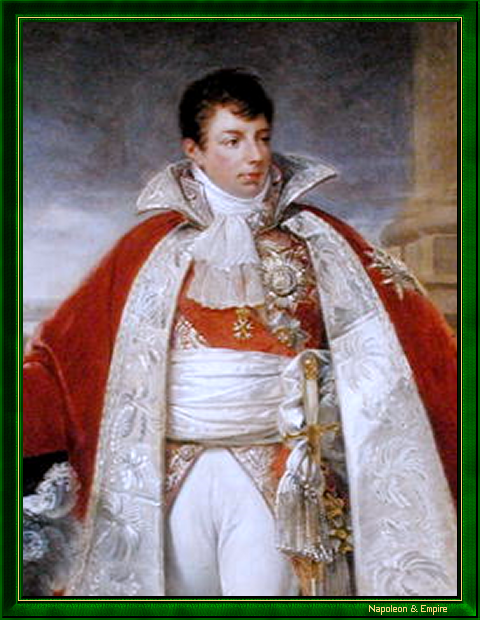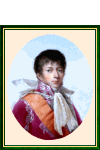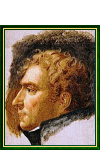Géraud Christophe de Michel du Roc a.k.a. Duroc
Duke of Friuli
Pronunciation:

Géraud-Christophe de Michel du Roc dit Duroc, of noble origin, was born in Pont-à-Mousson on October 25, 1772. In March 1792, he was admitted to the Châlons-sur-Marne artillery school, which he left in July before returning in March 1793. It is likely, but not certain, that he emigrated in the meantime.
In June 1793, as a lieutenant, he was posted to Grenoble and, a year later, to the Army of Italy. It was there, and not at the siege of Toulon as Emmanuel de Las Cases wrote, that he met Napoleon Bonaparte. The latter employed him as aide-de-camp.
Duroc distinguished himself at the crossing of the Isonzo (his courage was noted by the General-in-Chief in his report to the Directoire), and was promoted to battalion commander and chosen to take part in the Egyptian expedition. He distinguished himself once again, particularly at the siege of Saint-Jean d'Acre, where he was seriously wounded.
Returning to France with Napoleon Bonaparte on the Muiron, he played an active part in the coup d'état of 18 Brumaire, and was rewarded with the rank of brigade commander and the title of first aide-de-camp to the First Consul.
During the first two years of the Consulate, Duroc successfully carried out diplomatic missions with Frederick William III of Prussia and, above all, Alexander I, tsar of Russia, with whom he established a relationship of trust.
On his return to France at the end of 1801, he was appointed General and Governor of the Tuileries Palace.
In early 1802, Napoleon Bonaparte offered him the hand of Hortense de Beauharnais, but Duroc refused, preferring to marry the daughter of a Spanish banker.
With the proclamation of the Empire, he became grand marshal of the imperial palace, which, unlike other functions distributed at the time, was by no means a sinecure. He was in charge of repairs, alterations and extensions to the premises, all with a constant concern for economy; he was responsible for receiving dignitaries, ambassadors and generals, and for offering ceremonial dinners to all the personalities Napoleon I did not want at his personal table; he organized the Emperor's audiences; and he was in charge of the palace's police and security.
At the same time, Duroc continued to perform military duties, accompanying the Emperor on all his campaigns: at Austerlitz, he replaced the wounded Nicolas Oudinot as commander of the Grenadiers de la Garde; at Aspern-Essling, he led an artillery concentration. He was also involved in diplomatic affairs, for example in the negotiations preceding the renunciation of the Spanish kings Charles IV and Ferdinand VII.
Created Duke of Friuli in 1808 (in tribute to his exploits in this region during the Italian campaign), and appointed to the Conservative Senate on April 5, 1813, Duroc died on May 23 at Niedermackersdorf, near Görlitz in Silesia. On that day, a Russian cannonball, fired at a small group comprising Napoleon I, Duroc, Édouard Mortier, Armand de Caulaincourt and engineer general François Joseph Kirgener, ricocheted off the tree beside the Emperor, mowing down Kirgener, who died instantly, and Duroc, who agonized for several hours before passing away, despite the care provided by Dominique Jean Larrey.
During his last moments, spent in a nearby farmhouse, Duroc requested Napoleon's presence at his side and asked him to shorten his suffering, which the Emperor refused to do. A little later, Napoleon bought the farm and had a monument erected in memory of his faithful friend.
"Géraud-Christophe de Michel du Roc a.k.a. Duroc (1772-1813), Duke of Friuli" by Antoine-Jean Gros (Paris 1771 - Meudon 1835).

One of Duroc's unwritten duties was to assist in Napoleon's gallant adventures. He was seen keeping watch around a pavilion where Napoleon was frolicking with Madame Duchatel, and covering his master's inglorious retreat when the Emperor thought himself surprised.
Duroc, who along with Louis-Alexandre Berthier was one of Napoleon's most trusted confidants, also enjoyed the friendship of his leader. I was very saddened by the death of the Duke of Frioul, wrote the Emperor to impress Marie-Louise. He has been my friend for twenty years. [...] It is an irreparable loss, the greatest I could have made to the army
.
The transfer of Duroc's remains to Les Invalides , although decided by Napoleon I, did not take place until May 5, 1847.
Duroc's name is inscribed on the 15th column (east pillar) of the Arc de Triomphe de l'Etoile , while a full-length statue of the Duc de Frioul by Onésime Hulin honors his memory on the north façade of the Louvre, rue de Rivoli .
Remerciements
The photo of the full-length statue of the Duke of Frioul, rue de Rivoli in Paris, was kindly provided to us by Mr. Cyril MailletOther portraits

"Géraud-Christophe Duroc, Duke of Friuli". Miniature by Jean-Baptiste Isabey (Nancy 1767 - Paris 1855) from the Austerlitz Table (a.k.a. Table of the Marshals).

"Géraud-Christophe Duroc, Duke of Friuli". Nineteenth century print.

"Duroc, Grand Marshal of the Palace". Study by Anne-Louis Girodet de Roucy-Trioson (1767-1824).